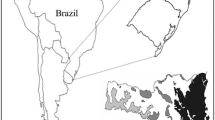Abstract
Shifting slash-and-burn agriculture is likely one of the main causes of forest degradation in southern Belize. Although many development projects have attempted to reduce the impacts of agriculture on the tropical rainforest, the situation is still a cause for concern. A study of the farming system of the San Jose Maya community was therefore carried out to examine agricultural production in its social, cultural, economic, and political context. Results demonstrate that agricultural production contributes to forest degradation because of the limited availability of agricultural land, the low level of investment in agricultural production, the land tenure system, limited marketing opportunities, and the exclusion of Mayas from the country's political and economic domains. Agroforestry could, however, offer a partial solution to the problem of forest degradation. Three types of traditional agroforestry systems are practised in San Jose: the milpa (a slash-and-burn agriculture system), cacao (Theobroma cacao) cultivation under shade trees, and the homegarden. These traditional agroforestry systems almost entirely meet a family's needs for food and wood, and generate at least 62% of family income. Improving the productivity of these systems could help to reduce pressure on the forest in southern Belize.
Similar content being viewed by others
References
Arya L and Pulver EL (1993) On-site appraisal of target areas for sustainable agriculture production activities. Natural Resource Management Protection Project (NARMAP), Belmopan, Belize
Barreto HJ (1994) Evaluation and utilization of different mulches and cover crops for maize production in Central America. In: Thurston HD, Smith M, Abawi G and Kearl S (eds) Tapado-Slash/mulch: How Farmers Use It and What Researchers Know About It, pp 157-168. CATIE/CIIFAD, Turrialba, Costa Rica
Berkey C (1994) Maya Land Rights in Belize and the History of Indian Reservations. Indian Law Resource Center, Washington, DC, USA. 35 pp
Boot RGA (1997) Extraction of non-timber forest products from tropical rain forests: Does diversity come at a price? Netherlands Journal of Agricultural Science 45: 439-450
Bruntland GH (1989) Notre avenir à tous. Éditions du Fleuve. Québec, Canada. 432 pp
Buckles D (1995) Velvet bean: A new plant with history. Economic Botany 46(1): 13-25
Bunch R (1994) The potential of slash/mulch for relieving poverty and environmental degradation. In: Thurston HD, Smith M, Abawi G and Kearl S (eds) Tapado-Slash/mulch: How Farmers Use It and What Researchers Know About it, pp 5-10. CATIE/CIIFAD, Turrialba, Costa Rica
Cowgill UM (1962) An agricultural study of the Southern Maya Lowlands. American Anthropologist 64: 273-286
Dove MR (1983) Theories of swidden agriculture, and the political economy of ignorance. Agroforestry Systems 1: 85-99
Dupriez H (1982) Paysans d'Afrique noire. Second Edition. Éditions l'Harmattan, Paris, France, pp 19-60
FAO (1997) Situación de los bosques del mundo. Food and Alimentation Organization, Roma, Italy. 200 pp
Gómez-Pompa A, Vásquez-Yanes C and Guevara S (1972) The tropical rain forest: a non renewable resource. Science 177: 762-765
Government of Belize (1996) Belize Abstracts of Statistics. Central Statistical Office, Ministry of Finance, Belmopan, Belize
Hammond N (1978) The myth of the milpa: agricultural expansion in the Maya Lowlands. In: Harrison PD and Turner BL (eds) Pre-Hispanic Maya Agriculture, pp 23-34. University of New Mexico, Albuquerque, USA
Jouve P (1988) Quelques réflexions sur la spécificité et l'identification des systèmes agraires. Les Cahiers de la Recherche et du Développement 20: 5-16
Kairi Consultants Limited (1996) Poverty Assessment Report-Belize. Kairi Consultants Limited, Tunapuna, Trinidad & Tobago
Kalpagé FSCP (1974) Tropical Soil. Macmillan cie, India. 238 pp
Lambert JDH and Arnason JT (1980) Nutrient levels in corn and competing weed species in a first year milpa, Indian Church, Belize, CA Plant and Soil 55: 415-427
Lévi-Strauss C (1971) Systèmes sociaux et dynamique culturelle. In: Lengyel P (ed) Approches de la science du développement socio-économique, pp 227-256. UNESCO, Paris, France
Mazoyer M and Roudart L (1997) Histoire des agricultures du monde: du néolithique à la crise contemporaine. Éditions du Seuil, Paris, France. 533 pp
Morley SG (1975) The Ancient Maya. Third edition. Stanford University Press, Stanford, USA. 465 pp
Mossu G (1990) Le cacaoyer. Éditions Maisonneuve et Larose, Paris, France. 132 pp
Nair PKR (1993) An Introduction to Agroforestry. Kluwer Academic Publishers, Dordrecht, The Netherlands. 499 pp
Nye PH and Greenland DJ (1960) The soil under shifting cultivation. Technical Communication No. 51. Commonwealth Bureau of Soils, Harpenden, United Kingdom. 153 pp
Palm CA, Swift MJ and Woormer P (1996) Soil biological dynamics in slash-and-burn agriculture. Agriculture, Ecosystems and Environment 58: 61-74
Raintree JB and Warner K (1986) Agroforestry pathways for the intensification of shifting cultivation. Agroforestry Systems 4: 39-54
Vosti SA and Witcover J (1996) Slash-and-burn agriculture-household perspectives. Agriculture, Ecosystems and Environment 58: 23-38
Author information
Authors and Affiliations
Corresponding author
Rights and permissions
About this article
Cite this article
Levasseur, V., Olivier, A. The farming system and traditional agroforestry systems in the Maya community of San Jose, Belize. Agroforestry Systems 49, 275–288 (2000). https://doi.org/10.1023/A:1006327403980
Issue Date:
DOI: https://doi.org/10.1023/A:1006327403980




